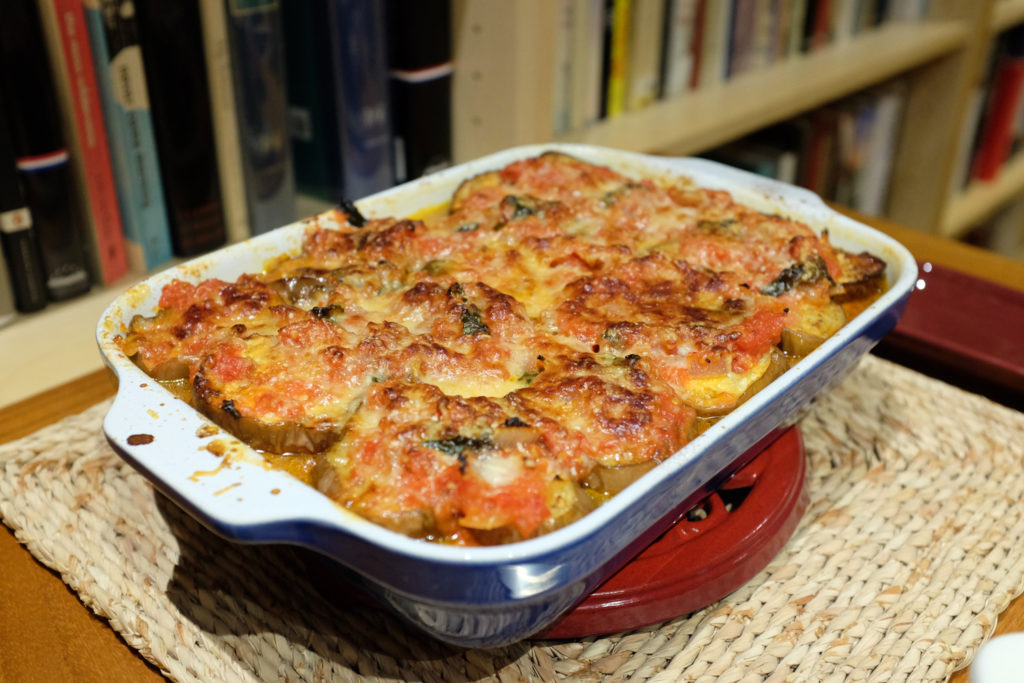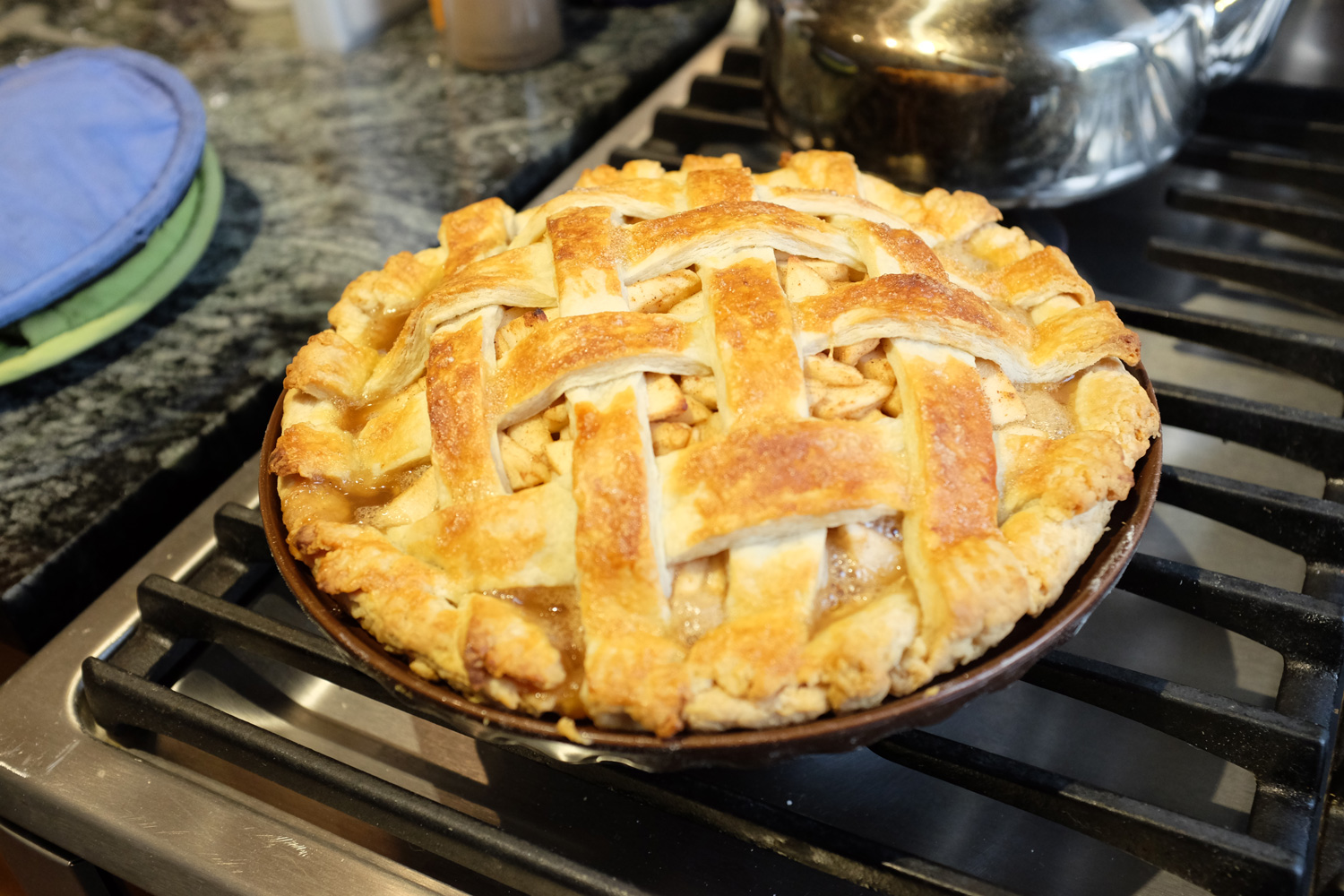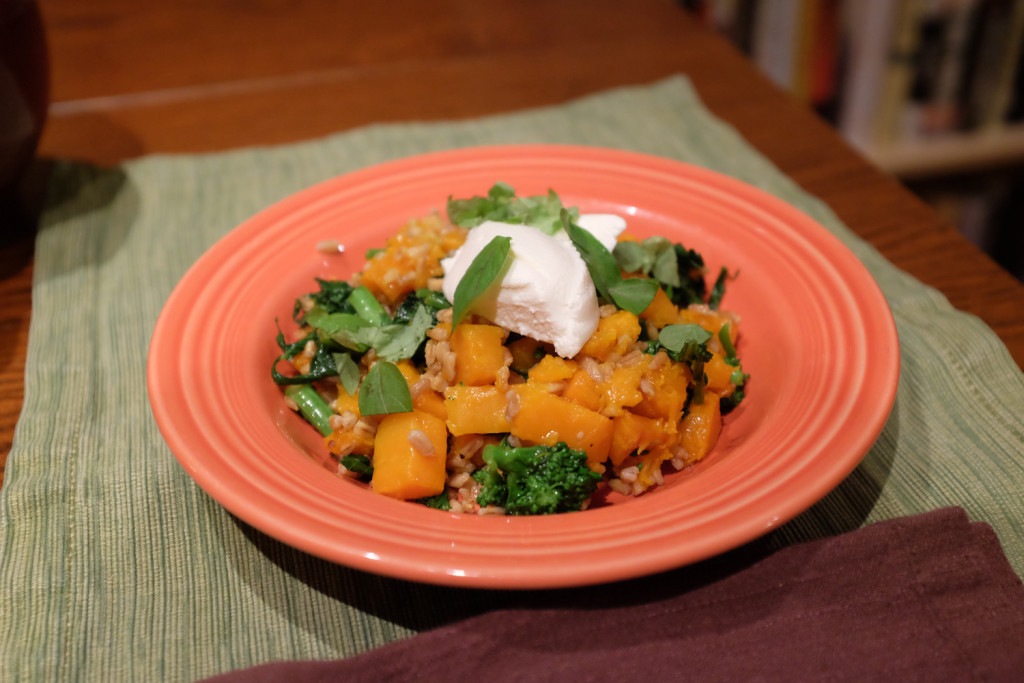
Three years ago I posted a recipe for apple pie on this blog, which I claimed to have proven with science. I hereby disavow it. It used vodka, and I’ve decided a little distilled white vinegar is as effective. I’ve also decided that using a food processor isn’t worth the trouble of cleaning it. And I’ve switched from corn starch to arrowroot, and from all-purpose flour to pastry flour. This version is better!
Ingredients:
dozen ice cubes
2 tbsp. distilled white vinegar
½ cup water
2 cups pastry flour
½ cup cake flour
2 tbsp. sugar
½ tsp. salt
2 sticks unsalted butter
½ cup brown sugar
3 tbsp. ground arrowroot
¼ tsp. salt
½ tsp. cinnamon
¼ tsp. nutmeg
1/8 tsp. allspice
2 tbsp. lemon juice
¼ tsp. vanilla
7 cups sliced Cortland and McIntosh apples (7–11 apples)
1 egg white
1 tsp. water
pinch of salt
demerara sugar
Equipment:
bench scraper
smooth surface
sandwich baggies
ceramic pie-baking dish
rolling pin
Instructions
Two days ahead of time:
Make fresh ice cubes.
One day ahead of time:
In a large mug or tumbler, combine ice cubes, vinegar, and water. Let stand.
On a smooth, clean surface—a clean countertop, or a large cutting board—pile in a mound the pastry flour, cake flour, sugar, salt, and butter. Chop and blend with the bench scraper until the largest visible pieces of butter are pea-sized.
Holding a knife across the lip of the mug, to catch the ice cubes, pour out exactly 2/3 cup of the vinegary meltwater. Pour a little of this meltwater into a furrow in the flour mixture. Immediately, with the bench scraper, blend water and flour together. Repeat until all the 2/3 cup of meltwater is well blended in. The flour mixture should be damp and a little scraggly, but not gooey. With your hands, clump it together into a ball. Push the ball flat with the heel of your hand, fold it over. Push it flat again; fold it again. Slice it in two with the bench scraper. Shape each half into a stubby disk, roughly the size and shape of a hockey puck. Slide each puck into a plastic sandwich baggie, seal the baggie, and refrigerate overnight (or for at least three hours).
The day itself:
Preheat the oven to 425ºF.
Lightly flour a rolling pin, a smooth surface, and both sides of one of the dough hockey pucks. With a closed fist, smush the hockey puck with the back of your knuckles, pressing gently and repeatedly, moving in a circle, in order to start the process of flattening it. Flip the puck over, and smush down repeatedly in a circle on the other side. Now roll the dough the rest of the way out with the rolling pin, lightly and repeatedly flouring it on both sides as you work in order to prevent it from sticking. Once it’s wide enough, place the flat sheet of dough in a ceramic pie-baking dish, letting it droop over the edges. Roll out the second hockey puck the same way, placing it flat on a large plate. Refrigerate both.
In a small mixing bowl, combine the brown sugar, ground arrowroot, salt, cinnamon, nutmeg, and allspice. Sift together with a fork.
Into a large mixing bowl, squeeze the juice of half a lemon (about 2 tbsp.). Add vanilla. Peel, core, and finely slice the apples, and as you measure them out, add them to the lemon juice in the bowl. Stir.
Take the chilled dough that’s in a pie plate out of the refrigerator. Gently press the dough down into the baking dish, to make sure it’s touching the ceramic. Fill a teacup with water and place it nearby. Bit by bit, fold the excess circumference of the pie shell inward, so that the edge of the new fold lies along the outer edge of the pie plate’s rim. Use your thumb, moistened with the water in the teacup, to smooth together the two layers of dough.
Once the pie shell looks right, mix the dry sugar and spices into the large bowl of lemon juice and apples. Stir until all the apple surfaces are coated, and then pour the mixture into the pie shell, along with juices. With your hands, shape the apples into a slight dome within the pie shell.
Slice the dough that’s lying flat on a dinner plate into eight parallel strips. Lay the first strip over the apple-dome vertically, just to the east of the north-south-running Greenwich meridian. Lay the second strip horizontally, just below the west-east-running Equator. Lay the third strip vertically, just to the west of the Greenwich meridian. Lift up the top of the first strip, gently folding it back toward you. Lay the fourth strip horizontally, just to the north of the Equator, so that it runs over the third strip but under the part of the first strip that you have lifted up. Then let the top of the first strip fall back into place. Continue laying strips, lifting and lowering the ends of other strips as necessary, aiming for a total of four vertical and four horizontal strips, interwoven. Fold the ends of the strips downward, tucking them under the lower pie shell and inside the pie-baking dish.
Whisk an egg white, a tsp. of water, and a pinch of salt in a mug, and brush onto the lattice and the perimeter of pie dough. Sprinkle demerara sugar along the lattice and perimeter as well.
Bake on a lower rack of the oven for 25 minutes, with a baking sheet on a rack beneath to catch spillover. Then lower the oven temperature to 375ºF, shift the pie to the oven’s middle rack, and bake for another 30 minutes. Let the pie sit on a trivet or cooling rack for at least three hours, until the juices from the apples are re-absorbed.




